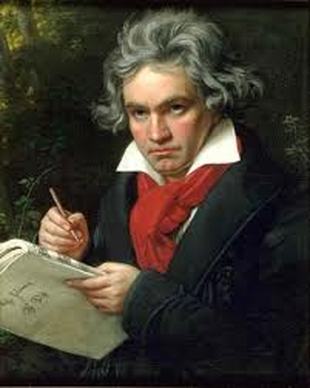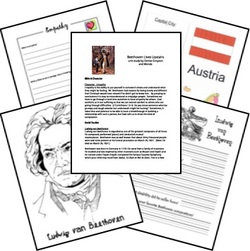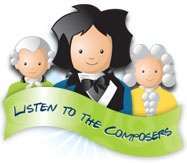Ludwig van Beethoven unit study
Classical Composer Unit Study: Ludwig van Beethoven
I have never thought of writing for reputation and honor.
What I have in my heart must out; that is the reason why I compose.
Ludwig van Beethoven Remark to Carl Czerny
|
For this unit study we did things a little different. After reading a bit of background information about Beethoven we pulled out the paints, pencils and coloring pages and started coloring and drawing while listening to his music. (Links to music are listed under Classics for Kids link) Not only was it relaxing the multi sensory experience helped the children engage more in the music.
after coloring for a time. We stopped and read the bit of trivia about Beethoven's hair. 
Background:
Born in Bonn, Germany on December 17, 1770 (or perhaps a day earlier according to some records), Beethoven had a miserable childhood. He was one of seven children, only three of whom survived to adulthood. Although he loved his gentle mother, Maria, he feared his hard‐ drinking, demanding father, Johann. Johann had no great talent, but he gave music lessonsto the children of the nobility. From the time Ludwig was a small boy, turning the iron handle of window shutters to hear the musical noise, the child had been absorbed by music. His father recognized the boy’s ability and nurtured it, possibly because he saw it as a source of income. In 1787, when he was seventeen, Beethoven made his first trip to Vienna, the city that would become his home. There, he was quickly immersed in the life of Europe’s cultural capital, even playing the piano for Mozart. Mozart’s prediction was: “You will make a big noise in the world.” Beethoven’s stay was cut short by a series of family tragedies. He returned to Bonn to his dying mother. Shortly after, his infant sister died. When hisfather lost his job, Beethoven had to take responsibility for the family. After his father’s death in 1792, Beethoven returned to Vienna for good. The serious boy had grown into a man who was by turns rude and violent, kind and generous. He helped raise money forthe only surviving child of Johann Sebastian Bach, who was living in poverty, and he donated new compositionsfor a benefit concertin aid ofUrsuline nuns. Despite his temper, Beethoven attracted friends easily. He studied piano with composer Franz Joseph Haydn. And even though the student‐teacher relationship failed, the two remained friends. In Vienna, Beethoven also met Mozart’s rival, Antonio Salieri – the man rumoured to have poisoned Mozart. Salieri was kind to Beethoven and, in return, Beethoven dedicated three violin sonatasto him. <From Arts Alive in Canada -read the full article the biography starts at page 10> Classical Music The classical period of music occurred from about 1730 to 1820. In addition to Beethoven, other well-known composers from this period include: Bach, Stamitz, Haydn, Salieri, Mozart, and Schubert. Most of the famous composers of that period were from Europe. Beethoven composed nine symphonies. Lots of other composers wrote more than that, but Beethoven’s Symphonies are very famous and have some distinguishing characteristics. His Third Symphony, for example, was the longest symphony ever written at that time. The beginning of the second movement of Beethoven’s Eighth Symphony imitates a metronome. Beethoven's Ninth was the first symphony to use voices and his Fifth Symphony may be the most famous piece of music ever written. |

A bit of Trivia
Beethoven's Hair Beethoven, the great composer, was ill for much of his adult life. He was also totally deaf when he created some of his best work. Before he died, he wrote a letter to his brothers, begging them to find out why he had been in such poor health. That letter is referred to as the Heiligenstadt Testament. Locks of the maestro’s hair, snipped from his head at the time of his death, have provided the answer Beethoven sought for so long. He had lead poisoning! 

Lapbook and Notebook Pages and other printables and eBooks
goes with the book Beethoven Lives Upstairs Book and Lesson Themes empathy, Beethoven, classical music, Austria, weaving fact with fiction, letter writing, ears, hearing, metronome, musical note math, ordinal numbers
|

AUDIO RESOURCES
Classics for Kids -- Mozart Six different programs related to Mozart.
Online Resources Audio Resources Piano Sonata 14 (Moonlight) Op 27
Symphony No. 3 (Erocia-meaning 'heroic') Opus 55
String Quartets opus 59, no.1-3 (Razumovsky Quartets)
they look like this (click ctrl+F to find on the page):
Quartetto d'Archi in Fa maggiore op. 59 n° 1
Quartetto d'Archi in Mi minore op. 59 n° 2
Quartetto d'Archi in Do maggiore op. 59 n° 3
Piano Concerto 5 (Emporer) Op 73 - sheet music here
Symphony No. 9 Opus 125 (the one with Ode to Joy at the end)
Piano Sonata 8 (Pathetique) Opus 13
Video Resources
Classics for Kids -- Mozart Six different programs related to Mozart.
Online Resources Audio Resources Piano Sonata 14 (Moonlight) Op 27
Symphony No. 3 (Erocia-meaning 'heroic') Opus 55
String Quartets opus 59, no.1-3 (Razumovsky Quartets)
they look like this (click ctrl+F to find on the page):
Quartetto d'Archi in Fa maggiore op. 59 n° 1
Quartetto d'Archi in Mi minore op. 59 n° 2
Quartetto d'Archi in Do maggiore op. 59 n° 3
Piano Concerto 5 (Emporer) Op 73 - sheet music here
Symphony No. 9 Opus 125 (the one with Ode to Joy at the end)
Piano Sonata 8 (Pathetique) Opus 13
Video Resources
- Beethoven Lives Upstairs DVD (also available for purchase from Amazon Instant Video)
- “Brand New Outfit” and “The Missing Invitation” both feature “Ode to Joy” from the 9th Symphony
- “Brothers and Sisters to the Rescue” and “Annie and the Beanstalk” both feature the theme from the 5th Symphony.
- There are also 2 other episodes “The Christmas Wish” and ”A Galactic Goodnight” (both feature “Fur Elise”)

HERE ARE SOME RECOMMENDED RESOURCE available for purchase for those who want to extend and expand their composer studies.
*we have not used all these specific resources as my children don't enjoy lap books - which is disappointing as the teacher thinks they are facinating! I can confidently recommend these companies as we have purchased resources or used their free samples throughout the years.
World’s Greatest Composers curriculum is to immerse students in the work of each composer so that they are well familiar with their style, methods and music.
from confessions of a homeschooler
Famous Composers Notebooking Pages
purchase from notebookingpages.com
History of Classical Music
for purchase from Beautiful Feet Books
Composer Lap Book
is a comprehensive study of 42 composers from homeschool in the woods
a long winded through interesting article on all aspects of Beethoven's life and compositions is here.
*we have not used all these specific resources as my children don't enjoy lap books - which is disappointing as the teacher thinks they are facinating! I can confidently recommend these companies as we have purchased resources or used their free samples throughout the years.
World’s Greatest Composers curriculum is to immerse students in the work of each composer so that they are well familiar with their style, methods and music.
from confessions of a homeschooler
Famous Composers Notebooking Pages
purchase from notebookingpages.com
History of Classical Music
for purchase from Beautiful Feet Books
Composer Lap Book
is a comprehensive study of 42 composers from homeschool in the woods
a long winded through interesting article on all aspects of Beethoven's life and compositions is here.
